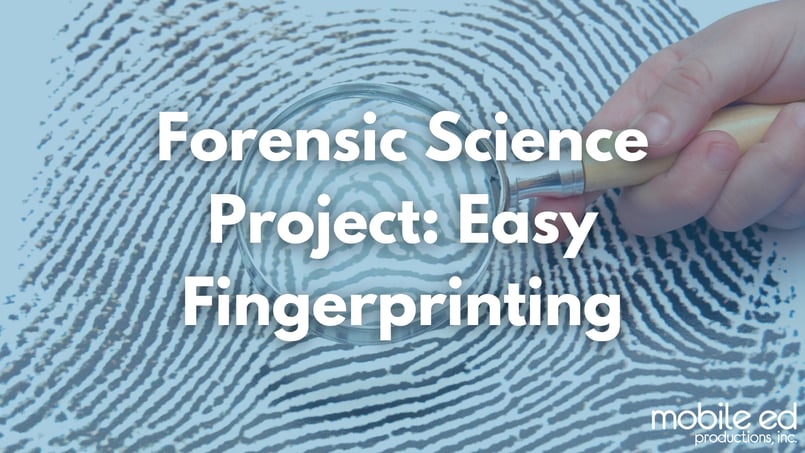
It’s a well-known fact that our fingerprints are completely unique to each of us. Mobile Ed Productions, Inc. has an easy forensic science experiment that will help your students take a closer look at the patterns that make us unique while laying a foundation for how science is used in crime investigation. For educators that teach remotely, this project can easily be completed at home.
Forensic science is the analysis of scientific evidence from a crime scene to create facts that can be used in investigations and criminal prosecutions. There are several different disciplines of forensic science that make up the field, but students will be focused on the discipline of “latent fingerprinting examination” for this experiment. Learn more about fingerprinting here.
In this forensics experiment, students will get the chance to work on team-building skills, develop better communication, and obtain a visible understanding of the unique identity they have right at their fingertips. Here are the three most common patterns in fingerprints you’ll want your students to notice while completing this experiment:
- Arches
- Loops (right and left)
- Whorls
What You’ll Need:
- Index cards
- Sharp pencils
- Transparent tape
- Good lighting
- Magnifying glasses (optional)
What You’ll Do:
- Divide students into partners or small groups.
- Each student will have three index cards. One index card will be used as a “stamp”, and the other two index cards will hold fingerprints.
- Label one index card “Right” and one index card “Left”.
- Use a pencil to make a “stamp” on the last index card by scribbling a filled-in swatch of pencil lead the size of a quarter. The residue from the pencil lead will be used to create the stamp. Make sure the swatch has enough lead pigment to transfer to a finger.
- TIP: Use cocoa powder as an alternative to pencil lead residue.
- Each student will rub their right index finger and right thumb into the stamp, covering the pads of the fingers completely. Students will want to cover their index finger from the tip of their finger to the first joint crease; this will capture the best fingerprints.
- Place pieces of tape over the residue on the index finger and the thumb. Be sure the tape covers the surface area from the tip to the first joint crease.
- Slowly remove the tape from each finger, placing it on the “Right” index card. Label each fingerprint as “Index” and “Thumb”. Students may need to repeat the tape transfer until the tape includes a clear, visible pattern.
- Repeat the above process on the left index finger and thumb. Students may need to add more pencil lead to their “stamp”.
- After all the prints are made and labeled, have students compare and contrast their prints with their group using the patterns pictured above. Use a magnifying glass to get a better look at your fingerprints!
ADVANCED VERSION: Have students create prints of all of their fingers. Make duplicates of your students’ fingerprint cards. Set up a “crime scene” in your teaching space and lay out a randomized set of fingerprints for students to find and identify. Based on the patterns of the criminal’s fingerprints, students can deduce the identity of the criminal.
Allow your students to use their new forensic skills to solve a mystery inside your school! Mobile Ed Productions Inc. has a well-known program called Crime Scene Science where students are able to solve a complex mystery using critical thinking skills and forensic science. During our 45-minute program, students will become forensic scientists by using chemistry, biology, and physics to solve the Case of the Catnapper!
In this exciting journey, students will get the chance to see forensic tools like they never have before! Our performer will bring in DNA analysis, use fingerprinting, restorative methods on a broken window, and make a casting of a footprint. Audience participation and live demonstrations will get your students thrilled about using science to solve real-life problems. Our Crime Scene Science program is also available virtually!
This program will teach students about:
- The Scientific Method
- Chemical indicators
- Castings and impressions
- DNA
- Fingerprinting
- Logic
Visit the Mobile Ed Productions, Inc. website to learn more about this criminally-fun program, or give us a call at 800-433-7459 to get help answering any of your questions.
Blog inspired by: HubPages






